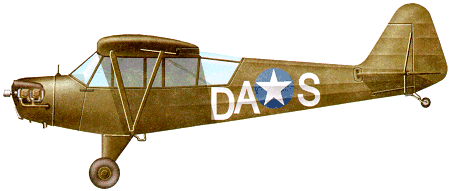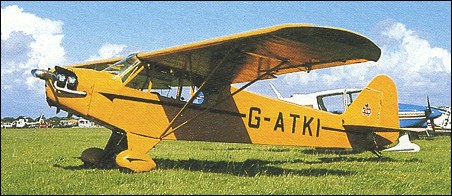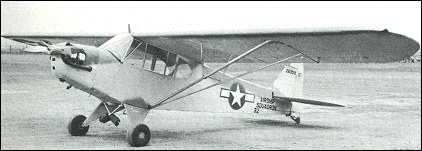|
| C. Gilbert Taylor and his brother had first established the Taylor Brothers Aviation Corporation in 1929 to market the Taylor Chummy lightplane; in 1931 the company was reorganised as the Taylor Aircraft Company, W. T. Piper Sr then being its secretary and treasurer. When the company ran into financial difficulties, manufacturing and marketing rights for the Taylor Cub, which had first flown in September 1930, were acquired by W. T. Piper who, in 1937, formed Piper Aircraft Corporation to continue production of this aircraft. A braced high-wing monoplane of mixed basic construction with fabric covering, the Cub had a conventional tail unit, fixed tailskid landing gear (the main units with wheels or optional floats) and an enclosed cabin seating two in tandem.
When first produced by Piper, the Piper J-3 Cub was powered by a 30kW Continental A40-4 flat-four engine, but it was not long before the 37kW A50-4 or alternative A50-5 with dual ignition system was introduced on the J-3C-50 Cub. The resulting improvement in performance made this already attractive lightplane an extremely marketable commodity and during 1938, which was the new company's first full year of production, no fewer than 737 Cubs were built. The Continental A50 was a new engine, early experience proving that it was reliable and had development potential, and it was later re-rated at 48kW at a higher engine speed. Its introduction by competitors meant that Piper had to follow suit, and in 1940 the J-3C-65 Cub appeared with the Continental A65 engine. With alternative Franklin flat-four engines, the 37kW 4AC-150 or 48kW 4AC-176, the Cub was designated J-3F-50 and J-3F-65 respectively and, similarly, with the Avco Lycoming 37kW O-145-A1 or 48kW O-145-B the Cub had the
respective designations J-3L-50 and J-3L-65. Also built in comparatively small numbers was a version designated J-3P-50, powered by a 37kW Lenape Papoose 3-cylinder radial engine. Sales began to soar, and then in 1941 the US Army selected this aircraft for evaluation in artillery spotting/direction roles, and shortly afterwards ordered 40 similar aircraft under the designation O-59. These aircraft.were used by the US Army under virtually operational conditions during annual manoeuvres at the end of 1941, and it was very soon discovered that the little Cub had far wider applications than at first anticipated.
This practical experience enabled the US Army to obtain an improved O-59A which, powered by a 48kW Continental O-170-3 flat-four engine, had better accommodation for the pilot and observer with an enhanced all-round view. Orders for O-59As totalled 948, but as a result of designation changes they entered service as L-4A aircraft, the earlier YO-59 and O-59 aircraft then being redesignated L-4, and the type later received the name Grasshopper. Subsequent procurements covered 980 of the L-4B version with reduced radio equipment, 1,801 of the L-4H variant with only detail changes, and 1,680 of the L-4J model which introduced a variable-pitch propeller. Civil-Cubs impressed for Army service at the beginning of World War II included eight J-3C-65s and five J-3F-65s which were designated L-4C and L-4D respectively. Piper was then requested to develop a training glider from the L-4 design and this, with powerplant removed and the forward fuselage redesigned to accommodate an instructor and two pupils, was built to a total of 250 for the US Army under the designation TG-8. Three of these gliders were acquired for evaluation by the US Navy under the designation XLNP-1 and this service also procured 230 NE-1 aircraft which, basically similar to the US Army's L-4s, were used as primary trainers; 20 similar aircraft procured at a later date were designated NE-2. When, post-war, production was switched to the further improved Cub J-4 Coupe, Piper had built a total of 14,125 civil and 5,703 military.

| MODEL | Piper J-3C-65 Cub |
| ENGINE | 1 x Continental A65 flat-four piston engine, 48kW |
| WEIGHTS |
| Take-off weight | 499 kg | 1100 lb |
| Empty weight | 290 kg | 639 lb |
| DIMENSIONS |
| Wingspan | 10.73 m | 35 ft 2 in |
| Length | 6.78 m | 22 ft 3 in |
| Height | 2.03 m | 7 ft 8 in |
| PERFORMANCE |
| Max. speed | 148 km/h | 92 mph |
| Ceiling | 3660 m | 12000 ft |
| Range | 402 km | 250 miles |
| William Muttera, e-mail, 05.02.2011 22:34 While in the navy in 1953 I decided to take flying lessons. Went up to Ream Field near San Diego. Soloed in a J-3 cub in a little under four hours. Completed my private in the same J-3. 40 years and 20,ooo hours later I retired flying a Citation X. I have always felt that the J-3, Stearman, and Citation I were the real "honest" airplanes that taught
my generation the basics that stayed with us all our lives. reply | | Don P.Simons, e-mail, 30.01.2011 06:40 Love the J-3! For 13 years I flew N2218M towing signs and taking pictures. We had a C-85 up front and with Steuban- McCandless letters it did just fine - One 43-letter sign was the longest and it did fine. On windy days around the fair ground I'd stand still or back up for fun. The helium balloons provided some fun when I took aim and hit them. Those strings wrapped around the prop shaft and I could hear them pop. Lande with the sigh attached one day when the tow-hitch got jammed. When the grappling hook dug in I made a carrier landing - no damage, just fun! Our camera attachment for pictures is in the Piper Museum in Lock Haven with some shots I took of Youngstown, Ohio for a new highway system. reply | | bill moore, e-mail, 23.01.2011 20:19 1st airplane was a J-3 85 hp N87951 bought in buffalo wy in 1969. flew it for 87 hrs. learned a lot in it. all previous time was in helicopters. reply | | Jim Shull, e-mail, 20.11.2010 05:41 My solo was in NC42657 at Boulder Colorado in 1949. It is said that every airman either flew one or wished he had! Great airplane. reply | |
| | Bob Lomas, e-mail, 15.11.2010 19:55 Dear Linda, Should you be interested email me and I will send you a photograph of 43-29934 on one of the occasions I flew it, it was at that time owned by Jack Anziani who had rebuilt it. reply | | Chuck, e-mail, 13.11.2010 05:22 I enter the Navy V-5 program in 1942, since tere was no vacancy in hre training program they had me go to a private school and get my private license, I also attended classes in flight theroy, navigation and weather as it pertained to flying. reply | | Ed Carney, e-mail, 18.10.2010 16:56 I took my private check ride 41 years ago in a J-3 (N2099M). Since then I have flown lots of planes, from military jets to modern airliners. The Cub is still my all time favorite for pure flying enjoyment and teaching basic flying skills. I have owned a Reed Clipped, 85hp Cub (NC98889) for over 20 years and don't plan on ever selling her. reply | | Jim Hupe, e-mail, 12.10.2010 20:46 Friends and I bought N1071N 1945 Army L-4J Piper J-3 C-64A in the 70s and flew her alot, my favorite of all my flying. She still flies and is in the WAAAM Museum in Hood River, Oregon, completely restored back to the original L-4J configuration, wish I had another here in Guatemala reply | | Adam, e-mail, 05.10.2010 05:39 well i soloed a 1946 J3 in sept. of last year.i have to say its my favorite flying that ive done reply | | Jerry Imbriale, e-mail, 04.10.2010 02:01 I soloed in 1960 in a 1946 J-3 Cub. Some 45 years later while browsing a list of active aircraft I was amazed to find that old Cub (now 60 years old !) still active and owned by a party in Indiana. They were kind enough to send me a photo and I have to say the years have been much kinder to the Cub then to me. reply | | Jack Northrup, e-mail, 30.09.2010 20:56 Soloed in July 1942, flight instructor for Air Force giving Aviation Students 10 hours to evaluate as good enough to become AF Aviation Cadets. Flew 1200 hours 1943-44 in J-3's, then activated and sent thru A /C program. Stearmans, At-6's and finally B-25's. War over just as training ended for me. reply | | Bob Kaplan, e-mail, 21.09.2010 18:38 My first time in an airplane was in 1946 at Long Beach Seaplane Base,L.I., NY. After 4:45 dual I soloed and went on to fly everything up to and including the B-727. I retired in 1990 after flying for Meteor Air Transport, Mohawk /Allegheny, USAIR with a total of 32,000 hours. It all started with the J-3 65HP on floats. I was 18 then and 82 now. My son is now with Continental soon to be United and I started him in Gliders at 15 in Salem, NH and then 10 hours in our Cessna 170B. reply | | Herb Seubert, e-mail, 13.09.2010 04:17 I signed up for the CPT program in 1939 at the University of Buffalo. After 35 hours of instruction and solo flying I passed my private pilot's test on May 11, 1940 in a Piper Cub J3L with a Lycoming 55 and aircraft license nbr NC-25027. I then went into the Army Air Corps Flying Cadet program at Glenview, Il and Maxwell Field and continued as a pilot in the US Air Force and ANG until retiring in 1962. The Piper J-3 started my career in aviation that changed my life. reply | | Bob Marsh, e-mail, 10.09.2010 20:54 In Apr 1958 @ the age of 21 I had my first Solo in the J-3 cub. It was at the alliance airport located on Rt 62 just East of town. My instructor was a man 6' tall and weighed about 220 lbs. I remember we were down wind leg and he reached up and turned the Mags OFF. (At that time I thought S---!!! I got it down all in one piece. He got out and I turned the mags on and he stuck his head back in the a /c and and said give me three t /o and landings. On t /o I rolled about 200' and was airborn scarred me!! I think that to this day after about 15,000 hrs those were the best landings I ever made.
Bob Marsh reply | |
| | David Luse, e-mail, 15.08.2010 15:43 When I moved to South West washington in 1982, I found a flying club with an old J-3, No. 21667. Built in September 1938, It was originally a 40hp, but had a 65hp continental by this time. I have flown a lot of ariplanes, but none more fun. 21667 is still happily plugging away after more than 70 years.
An interesting side note: When I was going through my fathers original log book from the Civilian Pilot Training Program, I found that he soled in 1938, in J-3 #21670. reply | | richard, e-mail, 12.05.2010 21:50 Anyone out there have an empty weight on a early wood spar J3?
Local mech says mine weighs 765 empty. Weighed 642 when born. reply | | Jesse Shannon, e-mail, 01.09.2010 03:54 I made my solo flight after 8 hours of instruction in a J-3 while a member of a flying club in Panama, Panama. I will never forget the experience. The tail number was HP-45. What a surprise I had with my first take off without the instructor in the front seat. Off the ground quickly. I hated the heel brakes and had much trouble landing. reply | | Bob West, e-mail, 02.03.2010 22:15 My first flight in an sircraft was in a J-3 Cub. Flight lesson number one. That was over 50 years ago.... Lots of air under many wings since then. reply | | Irvin Sternberg, e-mail, 25.02.2010 19:13 I learned to fly in a 50 horse power Piper Cub in the Civilian Pilot Training program in the summer of 1941, with a woman instructor. Later I enlisted in the Army Air Corps and flew a number of different planes including the P-38, but that first solo flight in a Piper Cub was the most thrilling flight of all. reply | | Verne Lietz, e-mail, 03.02.2010 04:38 My first time at the controls of a plane was in 1949 at the 8,100' airstrip at Westcliffe, Colorado. As I told a flying buddy later, "My first time at the controls was the most exciting time of my life, even better than my first sexual experience." His reply..."Yeah, and it lasted a lot longer too !" Soon after soloing I was offered a Cub for $541 (the trade-in value on a PA-16) and bought it. My wages were 85 cents an hour. I had 82 hours on it before I ever got below 5,000 feet altitude and then was amazed to get off in about 250 feet instead of a 2,000 foot run. One day, flying out of Salida, Co., "we" got in an updraft and went to 15,200 feet when I got weak from lack of oxygen. That was the highest I ever got in a prop driven plane, even in the Air Force later. (T-6 and B-25)I flew it from western Colorado to Minneapolios, back to Denver, then to Waco, Texas, later back to Minneapolis. That was all pilotage and dead reackoning. The Cub met it's demise when an 87 mph wind coming over the tail pushed a wing down to the ground in Iowa. In 1950 it cost much more to rebuild than to buy another plane..a 1941 T-craft for $450. reply |
|
Do you have any comments?
|
| 
COMPANY
PROFILE
All the World's Rotorcraft
|








